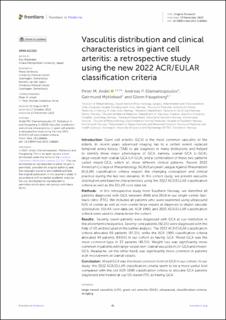| dc.contributor.author | Andel, Peter Michael | |
| dc.contributor.author | Diamantopoulos, Andreas P | |
| dc.contributor.author | Myklebust, Geirmund | |
| dc.contributor.author | Haugeberg, Glenn | |
| dc.date.accessioned | 2024-03-01T09:25:56Z | |
| dc.date.available | 2024-03-01T09:25:56Z | |
| dc.date.created | 2023-12-19T15:57:30Z | |
| dc.date.issued | 2023 | |
| dc.identifier.citation | Frontiers in medicine. 2023, 10 . | en_US |
| dc.identifier.issn | 2296-858X | |
| dc.identifier.uri | https://hdl.handle.net/11250/3120590 | |
| dc.description.abstract | Introduction: Giant cell arteritis (GCA) is the most common vasculitis of the elderly. In recent years, advanced imaging has to a certain extent replaced temporal artery biopsy (TAB) to aid diagnosis in many institutions and helped to identify three major phenotypes of GCA, namely, cranial GCA (c-GCA), large-vessel non-cranial GCA (LV-GCA), and a combination of these two patterns called mixed-GCA, which all show different clinical patterns. Recent 2022 American College of Rheumatology (ACR)/European League Against Rheumatism (EULAR) classification criteria respect the changing conception and clinical practice during the last two decades. In this cohort study, we present vasculitis distribution and baseline characteristics using the 2022 ACR/EULAR classification criteria as well as the EULAR core data set.
Methods: In this retrospective study from Southern Norway, we identified all patients diagnosed with GCA between 2006 and 2019 in our single-center fast-track clinic (FTC). We included all patients who were examined using ultrasound (US) of cranial as well as non-cranial large vessels at diagnosis to depict vascular distribution. EULAR core data set, ACR 1990, and 2022 ACR/EULAR classification criteria were used to characterize the cohort.
Results: Seventy-seven patients were diagnosed with GCA at our institution in the aforementioned period. Seventy-one patients (92.2%) were diagnosed with the help of US and included in the further analysis. The 2022 ACR/EULAR classification criteria allocated 69 patients (97.2%), while the ACR 1990 classification criteria allocated 49 patients (69.0%) in our cohort as having GCA. Mixed-GCA was the most common type in 33 patients (46.5%). Weight loss was significantly more common in patients with large-vessel non-cranial vasculitis in LV-GCA and mixed-GCA. Headache, on the other hand, was significantly more common in patients with involvement of cranial vessels.
Conclusion: Mixed GCA was the most common form of GCA in our cohort. In our study, the 2022 ACR/EULAR classification criteria seem to be a more useful tool compared with the old ACR 1990 classification criteria to allocate GCA patients diagnosed and treated at our US-based FTC as having GCA. | en_US |
| dc.language.iso | eng | en_US |
| dc.publisher | Frontiers Media | en_US |
| dc.rights | Navngivelse 4.0 Internasjonal | * |
| dc.rights.uri | http://creativecommons.org/licenses/by/4.0/deed.no | * |
| dc.title | Vasculitis distribution and clinical characteristics in giant cell arteritis: a retrospective study using the new 2022 ACR/EULAR classification criteria | en_US |
| dc.title.alternative | Vasculitis distribution and clinical characteristics in giant cell arteritis: a retrospective study using the new 2022 ACR/EULAR classification criteria | en_US |
| dc.type | Journal article | en_US |
| dc.type | Peer reviewed | en_US |
| dc.description.version | publishedVersion | en_US |
| dc.source.volume | 10 | en_US |
| dc.source.journal | Frontiers in medicine | en_US |
| dc.identifier.doi | 10.3389/fmed.2023.1286601 | |
| dc.identifier.cristin | 2215807 | |
| cristin.ispublished | true | |
| cristin.fulltext | original | |
| cristin.qualitycode | 1 | |

